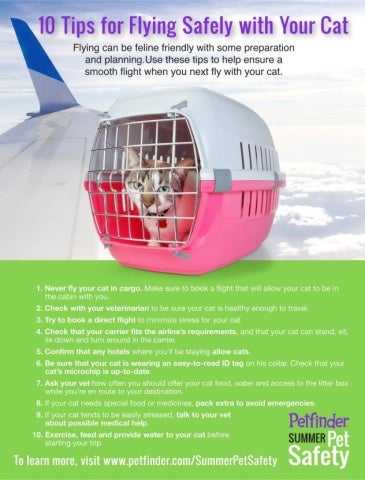Travel Tips For Flying With Cats

Thirty years ago I learned a valuable lesson flying from Montreal to Toronto, Canada with two cats.
On a bitterly cold December morning in 1980, my parents dropped me off at the airport with my two cats snuggled on a blanket in their cozy wicker carrier. I was excited about moving to Toronto and I envisioned a pleasant flight with my cats lounging on my lap with all of us enjoying the view.
My fantasy flight deflated when I was told the carrier was too big for the cabin and my cats had to fly in cargo, in a crate. “But it’s 20 below zero and I don’t have a crate and my flight’s leaving in twenty minutes”, I wailed. This was before cell phones, the Internet, or the wisdom of experience. A surly attendant shoved an unassembled crate for me to assemble on the airport floor while my cats sang a mournful opera. The scene was straight out of a comedy skit but the joke, it turned out, was on me.
My heart sank when I moved Mergatroyde and Lulu into their cold steel prison. I wasn’t even allowed to place their blanket inside the bare crate. I’ll never forget the abject terror in my cats’ eyes. It was the first time I’d seen that kind of fear with fully dilated pupils and my intuition screamed this is so wrong!
I’d fallen in love with cats with my first kitten, Tiger, at age three and felt an immediate ability to think like a cat and respect their nature. The nail-biting flight from hell lasted over an hour but felt like an eternity. Once we landed, I ran to the baggage carousel and waited for my precious cargo. You’d think they would have treated live animals better than luggage but they didn’t. Long after everyone had picked up their luggage I kept my tear-filled eyes glued on the baggage ramp. Finally, the metal torture chamber slid down the ramp, with my shivering cats mute from shock. The only visible evidence of their ordeal was a puddle of urine on the cold metal floor. The airline never returned my beautiful wicker carrier.
It’s hard to say who was more traumatized but I didn’t fly again with pets until twenty years later when I moved to New York a few weeks before 9/11. I vowed to never inflict unnecessary stress on any cat ever again. On the second flight with cats, I left nothing to chance or thought I had. I bought another passenger seat to comply with the one cat per passenger rule and double-checked the measurements of the carriers, but realized to my horror, once onboard, the hard-sided carriers didn’t fit under the seats. Luckily the kind flight attendant overlooked the discrepancy and Merlin and Coco serenaded the other passengers with non-stop Siamese singing. It wasn’t as relaxing as this image suggests. Tip: offer to buy irate passengers drinks.
Flying with Cats Tips Checklist:
1. Never fly your cat in cargo.
Make sure to book a flight that will allow your cat to be in the cabin with you. Check out some past pet-friendly airlines that have allowed pets in the cabin.
2. Visit your veterinarian
Check with your veterinarian to be sure that your cat is healthy enough to travel as well as to gather any papers and documents you’ll need. While you’re there, be sure to ask these questions of your veterinarian as well.
3. Try to book a direct flight
Doing so can minimize stress for your cat — and in turn, for you!
4. Check your carrier
Be sure that your carrier fits the airline’s requirements. Your cat should be able to stand up, lay down and turn around without any discomfort. Worried that your cat will hate the carrier? Try these steps to help your cat like his carrier at the start of your travel planning.
5. Confirm your hotels
Call and confirm that any hotels where you’ll be staying will also allow your cat. Worried about how your cat will behave in the hotel?
6. Don't forget identification
Check that your cat is wearing an easy-to-read tag on his collar. Don’t forget to also check that your cat’s microchip information is up-to-date. Haven’t microchipped your cat yet? Read why microchipping is so important.
7. Check the timing with your veterinarian
Ask your vet how often you should offer your cat food, water, and access to the litter box while you’re en route to your destination.
8. Pack extra supplies
If your cat requires special food or medications, be sure to pack extra to avoid emergencies.
9. Prepare for stress
If your cat tends to be easily stressed, talk to your vet ahead of time about possible medical help.
10. Before you leave
Exercise your cat with some playtime and provide food and water (unless otherwise directed by your veterinarian).
11. Share the infographic!
See all these tips in one easy-to-share infographic!